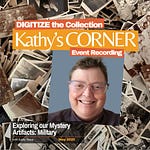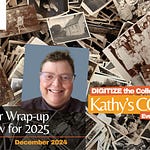Today’s session was a bit of a celebration as it marks the one-year anniversary of the first of
’s Kathy’s Corner. Over the twelve months, the series has methodically covered Kathy’s structured approach to digitizing a collection while dishing practical advice and encouragement. You can read more about that in Kathy’s post:Today’s session focused on the challenges of curating a collection and letting go of pieces. As Kathy put it,
We are the guardians of our family stories. Downsizing your collection is not the same as throwing out old socks. This is a legacy.
A few things you won’t want to miss in the video:
In the 2010s, photo organizers often shared a phrase that would have you sorting through your photo collection based on the so-called ABCs.
“A” What would you want to put in an Album (today that be put on view in some form, analog or digital)?
“B” What would you put in a Box to preserve for the long run?
“C” What would you just Can? (Or, dump into the trash or rubbish can.)
As Kathy points out, too often the “S” is forgotten:
“S” What would you use to share Stories? For all the reasons we focus on Stories, this can be the most important reason for keeping photos.
Kathy added…
When considering what to “Can,” consider other places to rehome images, from local history museums and thrift stores to creative-reuse shops and online sites like Dead Fred.
A later mnemonic came along to focus on three elements that matter:
HAVE: What are the things you need to have physically (consider items of monetary or sentimental value like jewelry, letters, or daguerrotypes)
SEE: This is seen but does not have a category that might include school pictures showing all class members.
KNOW: These stories, narratives, and connections are important to a family history.
Useful tips shared as links during the conversation:
Many photographic materials are not recyclable, so you will have to find ways to repurpose them or throw them in the trash. Consider:
Using photos for kids’ crafts that might repurpose them creatively
Shredding images and destroying digital materials (like data CDs and DVDs) for privacy reasons first.
Things to look for in photo-safe archival storage materials. The key here is a PAT (or Photo Activity Test) to ensure that the material used to protect these treasures doesn’t chemically interact and degrade the images.
Acid-free
Lignan-free
Buffered
Remember that preserving negatives can be a space-efficient way to keep an image even if you let go of original prints. Negatives are originals.
Useful links
Kathy came prepared with a series of useful resources, including her own @cropperkathy Pinterest board with an ongoing assortment of tips, suggestions, and ideas, plus these vendors from around the world:
CXD International: Conservation products and supplies cxdinternational.com
Preservation Equipment (PEL): “Giving history a future” preservationequipment.com
Archival Methods: Archival Storage and presentation products archivalmethods.com
CarrMclean: Library and archival products (Canada) carrmclean.ca
Gaylord Archival: “Preserve today. Share tomorrow.” gaylord.com
Uline: Office and factory supply source with archival materials. uline.com
Do you have more to add? Please post them in the comments and share this as a note to keep the conversation going and learn from each other.

















Share this post